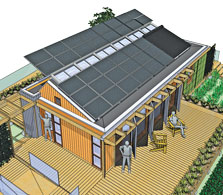

True to its name, Maryland's LEAFHouse is designed to bring light and the feeling of nature into the house. Translucent skylights traverse the length of the house.
Download Construction Drawings
(Zip 23 MB)
Neither the United States, nor the Department of Energy, nor the Alliance for Sustainable Energy LLC, nor any of their contractors, subcontractors, or their employees make any warranty, express or implied, or assume any legal liability or responsibility for the accuracy, completeness, or usefulness for any purpose of any technical resources or data attached or otherwise presented here as reference material.
Solar Decathlon 2007
University of Maryland
Team Web site: http://2007.solarteam.org/page.php?id=250
Branching out in Maryland
When designing their house, University of Maryland students drew inspiration from the simple, yet vastly complex leaf. "We see the leaf as nature's most efficient organism," says Brittany Williams, student and one of the leaders of the architectural team.
Inside the "LEAFHouse," at the ridge of the ceiling, exposed steel supports "branch out" from a wooden spine. This, along with a large expanse of glass, brings light and the feeling of nature into the house. Architecturally speaking, there's a strong connection between the exterior and interior of the house, with a green wall of plants on the south side.
"Just as the leaf changes throughout the year, so can this house, given the mood of the owner," says Jake Zager, student and co-manager of construction. The team sees a need for transformability in today's housing, which has many expressions in their design. For example, the interior features a series of movable, translucent panels that transform a small house into a large space.
Team members are particularly proud of their smart—house system called SHAC (for Smart House Adaptive Control). Two undergraduate computer engineering majors built a sensor network to bring the comfort level of the home to the ideal. The network monitors humidity, temperature, light, and whether the doors are open or closed-it's a Web-enabled system that can even factor in weather forecasts.
The most innovative feature of the Maryland house may be the indoor waterfall—a liquid desiccant wall system that's used to control humidity. As far as the team knows, such a system has never been used for a home.
The team has drawn heavily on university and community resources, with faculty and local industry professionals logging countless volunteer hours. Maryland Decathletes from the 2002 and 2005 competitions mentored this year's team.
"Our support system is strong," says Zager. "We've learned that the true benefit of the competition is the effort we put into it and how much we grow from doing this."
Team Contact
Amy Gardner
turbine@umd.edu
